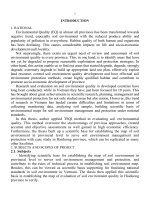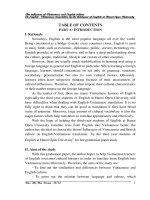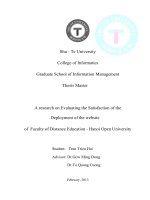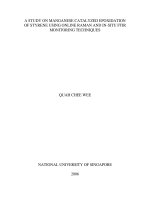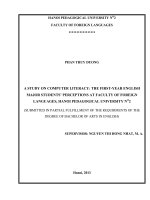A research on Evaluating the Satisfaction of the Deployment of the website of Faculty of Distance Education Hanoi Open University
Bạn đang xem bản rút gọn của tài liệu. Xem và tải ngay bản đầy đủ của tài liệu tại đây (763.46 KB, 106 trang )
Shu - Te University
College of Informatics
Graduate School of Information Management
Thesis Master
A research on Evaluating the Satisfaction of the
Deployment of the website
of Faculty of Distance Education - Hanoi Open University
Student: Tran Trieu Hai
Advisor: Dr.Gow Ming Dong
Dr.To Quang Cuong
February, 2013
Shu-Te University
Graduate School of
Information Management
Thes
is
A research on Evaluating the Satisfaction of
the Deployment of the website
of Faculty of Distance Education - Hanoi
Open University
Tran Trieu Hai
Fe
bru
ary
,
20
13
1、
3、
ii
A research on Evaluating the Satisfaction of the
Deployment of the website
of Faculty of Distance Education - Hanoi Open University
Student: Tran Trieu Hai
Advisor: Dr.Gow Ming Dong
Dr Dr.To Quang Cuong
A Thesis
Submitted to the
Graduate School of Information Management
College of Informatics
Shu-Te University
In Partial Fulfillment of the Requirements
For the Degree of
Master of Science
In
Information Management
February, 2013
iii
樹德科技大學
SHU-TE University
碩博士學位考試成績評分表
Evaluation Form for Master/Doctor Thesis
系所名稱
Graduate
School
學 制
Program
碩士班/Master Program
碩 士 在 職 專 班 /
In-Service Master Program
博士班/Doctor Program
學 號
Student ID
11731306
姓 名
Name
Tran Trieu Hai
論文題目
Thesis Topic
A research on Evaluating the Satisfaction of the Deployment of the
website of Faculty of Distance Education - Hanoi Open University
總 評
Comments
評 分
(大 寫)
Score
iv
考試委員
簽 章
Signature
樹德科技大學碩士班研究生
Graduate Student of Shu-Te University
指導研授推薦書
Recommendation Letter from Thesis Adviser
本校資訊管理研究所 君
所提之論文係由本人指導撰述,同意提付審研。
This Student, Tran Trieu Hai, whose thesis entitled
, is under my advisory and agree to submit for examination.
主要指導研授
Adviser
:
共同指導研授
Co-Adviser
:
年/Year 月/Month 日/Day
樹德科技大學碩士班研究生
v
Graduate Student of Shu-Te University
學位考試審定書
Qualification Form of Master Degree
100 學年度第 2 學期
_________研究所 君所提之論文
題目:_____________________________________________
經本學位考試委員會審議,認研符合碩士資格標準。
Student Name:Tran Trieu Hai
Thesis Title:A research on Evaluating the Satisfaction of the
Deployment of the website of Faculty of Distance Education - Hanoi
Open University.
This is to certify that the thesis submitted by the student named above
in summer, 2013. It is qualified and approved by the Thesis
Examination Committee.
召集人
Chair, Thesis Committee
:
委 員
Committee Member
:
委 員
Committee Member
:
主要指導研授
Adviser
:
共同指導研授
Co-Adviser
:
系所主管
Director of Department
:
年/Year 月/Month 日/Day
vi
ABSTRACT (Vietnamese)
Hiện nay, việc cung cấp thông tin của Khoa Đào tạo Từ xa tới các Trung tâm Liên kết
đào tạo cũng như tới các học viên đều phải thông qua hệ thống chuyển phát nhanh EMS, điện
thoại. Tuy nhiên, do nhiều trung tâm, học viên ở tại các địa phương xa, đi lại khó khăn nên
việc gửi thông báo, đề cương, lịch học, lịch thi của Khoa Đào tạo từ xa đến các Trung tâm và
học viên không được được kịp thời thậm chí là bị hỏng, thất lạc. Vì vậy, Website Khoa Đào
tạo Từ xa – Viện Đại học Mở Hà Nội được xây dựng và phát triển nhằm mở thêm một kênh
thông tin từ Khoa Đào tạo Từ xa – Viện ĐH Mở Hà Nội tới sinh viên, công khai các hoạt
động của Khoa Đào tạo Từ xa – Viện Đại Học Mở Hà Nội, tránh một số kẻ xấu lợi dụng việc
thiếu thông tin để thu thêm các khoản kinh phí của sinh viên, quảng bá hình ảnh, thông tin về
Khoa Đào tạo Từ xa – Viện Đại Học Mở Hà Nội.
Sau hơn 2 năm triển khai, Website của Khoa Đào tạo Từ xa – Viện Đại học Mở Hà
Nội được đánh giá là một kênh thông tin rất quan trọng.
Kết quả của luận văn nhằm đánh giá mức độ hài lòng của người dùng với hệ thống
Website của Khoa Đào tạo Từ xa – Viện Đại học Mở Hà Nội, tìm ra các giải pháp nâng cấp
về website của Khoa Đào tạo Từ xa – Viện Đại học Mở Hà Nội, đề xuất các giải pháp nâng
cấp, bổ sung chức năng, mở rộng, nâng cấp thiết bị giúp cho hệ thống hoạt động ổn định
Keyword: Website, Khoa Đào tạo Từ xa – Viện Đại học Mở Hà Nội, Sự hài lòng của
người dùng, mô hình IS Success, chất lượng thông tin, chất lượng hệ thống, chất lượng dịch
vụ, sử dụng dịch vụ.
ABSTRACT (ENGLISH)
Currently, information provision of the Faculty of Distance Education – Ha Noi Open
University to joint training centers as well as to learners must pass EMS express delivery
system, telephone. However, because many centers, learners at localities are at far distance,
difficult to travel, therefore sending notices, draft, timetable, exam schedule of the Faculty of
Distance Education to the centers, learners is not in time, even if damaged, lost. Thus the
Website of the Faculty of Distance Education - Hanoi Open University is build and
developed to expand an information channel from the Faculty of Distance Education – Hanoi
Open University to students, be in open of activities of the Faculty of Distance Education -
Hanoi Open University, avoid some evildoers to abuse insufficient information to collect
additional expenditures of students, advertise images, information on the Faculty of Distance
Education - Hanoi Open University.
After over 2 years in use, Website of the Faculty of Distance Education - Hanoi Open
University is evaluated as very important information channel.
The purpose of this thesis is to Evaluating User’s satisfaction with Website system of
the Faculty of Distance Education - Hanoi Open University. Results of the thesis are to find
out upgrading solutions for website of the Faculty of Distance Education - Hanoi Open
University. With reference to the results of a number of studies evaluating user satisfaction
have been published in scientific journals, newspapers of many authors, this study will use
the IS Success model to evaluate the user satisfaction with Website of the Faculty of Distance
Education - Hanoi Open University.
Keywords: Website, the Faculty of Distance Education - Hanoi Open University,
User’s satisfaction, information system success model, system quality, information quality,
service quality
Acknowledgements
It was an honor for me to be here today to express my gratitude to all those who
helped me with excellent support during the course MIS6.
First, I express my deepest gratitude to the instructions of Dr. Gow Ming Dong and
Dr. Ton Quang Cuong is guided to their widespread, continuous ideas and patience with me
during my thesis. Consulting their inspiring is extremely necessary and valuable for me to
complete my thesis. Both of them are really knowledgeable, professional and nice to me at
any time, any situation. I feel very fortunate and appreciate them for providing me the
opportunity to student friends of them.
I also want to express sincere gratitude to all my professors and lecturers at the
Department of Information Management and support for my friends, in time I learned in
Vietnam with the instructions of them.
Special thanks with friends at the HaNoi Open University - who has helped me a lot
to complete the questionnaire, for suggestions and advice relevant to my thesis.
Above all, I would like to thank my parents for their constant love and support. And,
most importantly, I would like to thank my wife and my daughter, whose make my life
wonderful and happiness.
Warmly thank my best!
Table of Contents
ABSTRACT (Vietnamese) 1
ABSTRACT (ENGLISH) 2
Acknowledgements 3
Table of Contents 4
List of Table 6
List of Figures 7
ABBREVIATIONS 8
Chapter 1: Introduction 9
1.1. Background of the study 9
1.2. Importance of the study 10
1.3. Research motivation 12
1.4. Statement of the Problem 12
1.5. Research Procedure 12
Chapter 2: Literature review 14
2.1. History of the World Wide Web 14
2.1.1. Early browsers 17
2.1.2. Early Search Engines 18
2.1.3. Web organization 18
2.1.4. Web 2.0 20
2.2. Joomla 22
2.3. Website of Faculty of Distance Education 24
2.3.1. Structure of contents 24
2.3.2. Technical features 25
2.4. Information System Success Model 25
2.5. User satisfaction 27
2.6. System quality 28
2.7. Information quality 29
2.8. Sevice quality 30
Chapter 3: Research Method 34
3.1. Research Design 34
3.1.1. The D&M IS Success Model 34
3.1.2. Updated D&M IS Success Model 35
3.1.3. Research Model 37
3.2. Research Hypothesis 39
3.2.1. The Website System quality has a positive effect to System use 39
3.2.2. The Website system quality has a positive effect to User’s satisfaction 39
3.2.3. The Website information quality has a positive effect to System use 40
3.2.4. The Website information quality has a positive effect to User’s satisfaction 41
3.2.5. The Website service quality has a positive effect to System use 42
3.2.6. The Website’s Service quality has a positive effect to User’s satisfaction 42
3.2.7. System use has a positive effect to User’s satisfaction 43
3.2.8. User’s satisfaction has a positive effect to System use 44
3.3. Measurement of Variables 48
3.4. Sample 49
3.5. Tool Development 50
3.5.1. Question design 50
3.5.2. Pilot study 50
3.5.3. Data collection 51
3.5.4. Research procedure 51
Chapter 4: Data Analysis 53
4.1. Descriptive analysis and sample demographic 53
4.1.1. Sample description 53
4.1.2. Sample Characteristics 57
4.2. Scale testing 59
4.2.1. Cronbach Alpha testing 59
4.2.2. Analysis Factor 66
4.3. Result of Correlation Analysis 68
4.5. Finding and discussion 79
Chapter 5: Conclusion 81
5.1. Conclusion 81
5.2. Contribution and implication 82
5.2.1.Contributions 82
5.2.2.Implication 83
5.3. Research limitations 84
5.4. Future research suggestions 85
Reference 86
Appendix A: QUESTIONNAIRES SURVEY 94
List of Table
Table 1: Summary of research hypotheses 46
Table 2: Measurement of Variables 48
Table 3: The specific parameters 54
Table 4: Gender 54
Table 5: Age 56
Table 6: Education 56
Table 7: Job 56
Table 8: IT Experience 57
Table 9: Frequency Use Computer 57
Table 10: Sample Characteristics 57
Table 11: Results of Information Quality Cronbach Alpha Testing 60
Table 12: Results of SQ Cronbach Alpha Testing 61
Table 13: Results of Service Quality Cronbach Alpha Testing 62
Table 14: Results of System Use Cronbach Alpha Testing 63
Table 15: Results of User Satisfaction Cronbach Alpha Testing 64
Table 16: Total results of Cronbach Alpha Testing 66
Table 17: Results of Analysis Factor 66
Table 18: Result of Correlation Analysis 68
Table 19: Result of ANOVA Analysis 76
Table 20: Research hypotheses and results 80
Table 21: Research hypotheses and results 82
List of Figures
Figure 1: The D&M Original IS Success Model 27
Figure 2: Gap model of Service Quality 32
Figure 3: IS Success model 35
Figure 4: IS Success model Update 37
Figure 5: Research Framework 38
Figure 6: Research procedure 52
Figure 7: Model 1 73
Figure 8: Results of the Model 1 75
Figure 9: Model 2 76
Figure 10:Result of Model 2 78
Figure 11: Research hypotheses and results 79
ABBREVIATIONS
1.
HTTP HyperText Transfer Protocol
2.
HTML HyperText Markup Language
3.
CMS Content management system
4.
D&M DeLone and McLean
5.
IS Success model Information System Success Model
6.
PCA Principal Component Analysis
Chapter 1: Introduction
Contents of Chapter 1 include introduction to general information on information
technology development of Vietnam, birth circumstance of website of the Faculty of Distance
Education - Hanoi Open University, from that point, put forth research motivations,
objectives.
1.1. Background of the study
Entering the 21
st
century, the scientific and technological revolution has continued
strong development, especially the information and communication technology, biological
technology, new materials, mechanics, electronics, automation,… as background for
intellectual economic development. Science and technology have actually become basic
motive power for socio-economic development. Education is a foundation to develop science
and technology, human resources, to improve talents and cultural standards of the people to
meet demands of modern society. In that background, Vietnam must quickly train high
quality human resources, research and apply specific technologies to have a position in
technology industry of the world.
This era is witnessing newly outstanding position of tertiary education. Most of
universities in the world are thirsty for comprehensive reform to become centers for training,
scientific research, technology transfer, intellectual export and rapidly develop in the
direction of “Popularization, marketization, diversification and internationalization”.
Therefore, countries consider tertiary education development as centralized duties of their
socio-economic development strategies, reserve for the tertiary education with many priority
investments to expand scale, improve human resource training quality and ensure social
equality.
Information and communication technology has been applied widely in large scale in
all life and social fields, especially in education. Thanks to connecting network, technologies
and knowledge have overcome borders of geography, of human groups to become knowledge
9
property of the community. Distance Education has become strength of the era, created an
open education without distance, satisfactory with demand of each learner. Open education
system held at every time, everywhere, at various levels and for all has become the most
effective solution to satisfy higher and higher requirements on education of the whole society.
“Education for All” becomes requirements and commitments of each country and “Life-long
learning” has become demand and obligation of each citizen.
Booming of science and technology, integration process and education renovation,
development has been happening at global scale, created opportunity so that the education in
general and the tertiary education in particular of Vietnam may quickly approach new trend,
theoretical bases, management organization and new training methods, modern lecturing
contents and utilize international experiences for development.
The information and communication technology of Vietnam in recent years has
developed with rapid speed. According to statistics of 7/2009, all the country had over 2
millions of wide brand Internet subscribers and over 16 millions of Internet users. Network
infrastructure has been gradually upgraded and had higher quality, especially transmission
line speed of Internet ADSL has had clear renovation. Alost universities, colleges in the
whole country are connected to Internet. Mass of software technology and content solutions
of advanced Internet were born, such as 3D technology, WEB 2.0, social network, Unified
Communication solution, especially 3G technology have been deployed in Vietnam, this shall
promise an effective application environment for training content communication, connection
between learners and teachers, the information and communication technology actually
becomes an important tool for development of Distance Education in Vietnam.
1.2. Importance of the study
As an administrator of website system of the Faculty of Distance Education - Hanoi
Open University, I have duties to ensure the website system in stable operation, propose
solutions for development of website. Therefore, results of study are useful for me in
10
particular, as well as for the Faculty of Distance Education - Hanoi Open University in
general. There is still no research showing users’ satisfaction on quality of the website system
of the Faculty of Distance Education - Hanoi Open University. Therefore, should have a
research, evaluation on users’ satisfaction with the website system of the Faculty of Distance
Education - Hanoi Open University.
Development of website of the Faculty of Distance Education
Currently, information provision of the Faculty of Distance Education to joint training
centers as well as to learners must pass EMS express delivery system, telephone. However,
because many centers, learners at localities are at far distance, difficult to travel, therefore
sending notices, draft, timetable, exam schedule of the Faculty of Distance Education to the
centers, learners is not in time, even if damaged, lost. Thus the Website of the Faculty of
Distance Education - Hanoi Open University is build and developed to:
- Expand an information channel from the Faculty of Distance Education – Hanoi
Open University to students.
- Be in open of activities of the Faculty of Distance Education - Hanoi Open
University.
- Avoid some evildoers to abuse insufficient information to collect additional
expenditures of students.
- Advertise images, information on the Faculty of Distance Education - Hanoi Open
University.
After over 2 years in use, Website of the Faculty of Distance Education - Hanoi Open
University is evaluated as very important information channel. Averagely there are about
2000 access times. Total current access times are over 3,100,000.
Thesis title: An Empirical Study on Evaluation of satisfaction level of website of Faculty of
Distance Education - Hanoi Open University after 2 years in use.
11
Purposes of the research
To contribute evaluation of importance of information advertisement on the Faculty of
Distance Education - Hanoi Open University on Website
To put forth solutions for upgrading, supplementing, fulfilling functions of website.
1.3. Research motivation
1. Posting information on website helps learners easy to access at every where and
every time.
2. Hanoi Open University has had no study about User’s satisfaction for website of
the Faculty of Distance Education
3. To propose upgrading, supplementing, fulfilling functions of Website
1.4. Statement of the Problem
Currently, although the information technology in Vietnam is developed with rapid
speed, but at many localities, knowledge level on information technology is poor, material
facilities such as computers, internet transmission lines are poor.
Many learners of the Faculty of Distance Education at remote, far religions are rarely
used computers, used internet to access the website of the Faculty.
Many learners of the Faculty of Distance Education are advanced in years, using
functions on the website of the Faculty are limited.
1.5. Research Procedure
In order to implement this thesis, the author has applied the following Research
Procedures:
Step 1: Determination of research purposes
Step 2: Research documents
Step 3: Design of research frame and supposition
Step 4: Design of questionnaires and pilot test
12
Step 5: Distribution of questions to participants
Step 6: Collection of data from participants
Step 7: Data analysis
Step 8: Definition of factors and models
Step 9: Review, conclusion and proposal
13
Chapter 2: Literature review
In this Chapter, I shall define some basic concepts as well as researches in relation to
this theme such as concept about user’s satisfaction, service quality, System quality, …. On
the basis of these concepts, I choose to use IS success model for evaluation
2.1. History of the World Wide Web
The World Wide Web ("WWW" or simply the "Web") is a global information
medium which users can read and write via computers connected to the Internet. The term is
often mistakenly used as a synonym for the Internet itself, but the Web is a service that
operates over the Internet, just as e-mail also does. The history of the Internet dates back
significantly further than that of the World Wide Web.
The hypertext portion of the Web in particular has an intricate intellectual history;
notable influences and precursors include Vannevar Bush's Memex, IBM's Generalized
Markup Language, and Ted Nelson's Project Xanadu.
The concept of a home-based global information system goes at least as far back as
"A Logic Named Joe", a 1946 short story by Murray Leinster, in which computer terminals,
called "logics," were in every home. Although the computer system in the story is centralized,
the story captures some of the feeling of the ubiquitous information explosion driven by the
Web.
In 1980, Tim Berners-Lee, an independent contractor at the European Organization
for Nuclear Research (CERN), Switzerland, built ENQUIRE, as a personal database of
people and software models, but also as a way to play with hypertext; each new page of
information in ENQUIRE had to be linked to an existing page.
In 1984 Berners-Lee returned to CERN, and considered its problems of information
presentation: physicists from around the world needed to share data, and with no common
machines and no common presentation software. He wrote a proposal in March 1989 for "a
14
large hypertext database with typed links", but it generated little interest. His boss, Mike
Sendall, encouraged Berners-Lee to begin implementing his system on a newly acquired
NeXT workstation. He considered several names, including Information Mesh, The
Information Mine (turned down as it abbreviates to TIM, the WWW's creator's name) or
Mine of Information (turned down because it abbreviates to MOI which is "Me" in French),
but settled on World Wide Web.
He found an enthusiastic collaborator in Robert Cailliau, who rewrote the proposal
(published on November 12, 1990) and sought resources within CERN. Berners-Lee and
Cailliau pitched their ideas to the European Conference on Hypertext Technology in
September 1990, but found no vendors who could appreciate their vision of marrying
hypertext with the Internet.
By Christmas 1990, Berners-Lee had built all the tools necessary for a working Web:
the HyperText Transfer Protocol (HTTP) 0.9, the HyperText Markup Language (HTML), the
first Web browser (named WorldWideWeb, which was also a Web editor), the first HTTP
server software (later known as CERN httpd), the first web server, and the first Web pages
that described the project itself. The browser could access Usenet newsgroups and FTP files
as well. However, it could run only on the NeXT; Nicola Pellow therefore created a simple
text browser that could run on almost any computer called the Line Mode Browser.To
encourage use within CERN, Bernd Pollermann put the CERN telephone directory on the
web — previously users had to log onto the mainframe in order to look up phone numbers.
According to Tim Berners-Lee, the Web was mainly invented in the Building 31 at
CERN ( 46.2325°N 6.0450°E ) but also at home, in the two houses he lived in during that
time (one in France, one in Switzerland).
On August 6, 1991, Berners-Lee posted a short summary of the World Wide Web
project on the alt.hypertext newsgroup.This date also marked the debut of the Web as a
publicly available service on the Internet.
15
Paul Kunz from the Stanford Linear Accelerator Center visited CERN in September
1991, and was captivated by the Web. He brought the NeXT software back to SLAC, where
librarian Louise Addis adapted it for the VM/CMS operating system on the IBM mainframe
as a way to display SLAC’s catalog of online documents; this was the first web server outside
of Europe and the first in North America.
An early CERN-related contribution to the Web was the parody band Les Horribles
Cernettes, whose promotional image is believed to be among the Web's first five pictures.
In keeping with its birth at CERN, early adopters of the World Wide Web were
primarily university-based scientific departments or physics laboratories such as Fermilab
and SLAC.
Early websites intermingled links for both the HTTP web protocol and the then-
popular Gopher protocol, which provided access to content through hypertext menus
presented as a file system rather than through HTML files. Early Web users would navigate
either by bookmarking popular directory pages, such as Berners-Lee's first site at
or by consulting updated lists such as the NCSA "What's New" page.
Some sites were also indexed by WAIS, enabling users to submit full-text searches similar to
the capability later provided by search engines.
There was still no graphical browser available for computers besides the NeXT. This
gap was filled in April 1992 with the release of Erwise, an application developed at the
Helsinki University of Technology, and in May by ViolaWWW, created by Pei-Yuan Wei,
which included advanced features such as embedded graphics, scripting, and animation.
ViolaWWW was originally an application for HyperCard. Both programs ran on the X
Window System for Unix.
Students at the University of Kansas adapted an existing text-only hypertext browser,
Lynx, to access the web. Lynx was available on Unix and DOS, and some web designers,
16
unimpressed with glossy graphical websites, held that a website not accessible through Lynx
wasn’t worth visiting. [28]
2.1.1. Early browsers
The turning point for the World Wide Web was the introduction of the Mosaic web
browser in 1993, a graphical browser developed by a team at the National Center for
Supercomputing Applications (NCSA) at the University of Illinois at Urbana-Champaign
(UIUC), led by Marc Andreessen. Funding for Mosaic came from the High-Performance
Computing and Communications Initiative, a funding program initiated by then-Senator Al
Gore's High Performance Computing and Communication Act of 1991 also known as the
Gore Bill.
Remarkably the first Mosaic Browser lacked a "back button" which was proposed in
1992-3 by the same individual who invented the concept of clickable text documents. The
request was emailed from the University of Texas computing facility. The browser was
intended to be an editor and not simply a viewer, but was to work with computer generated
hyper text lists called "search engines".
The origins of Mosaic date to 1992. In November 1992, the NCSA at the University
of Illinois (UIUC) established a website. In December 1992, Andreessen and Eric Bina,
students attending UIUC and working at the NCSA, began work on Mosaic. They released an
X Window browser in February 1993. It gained popularity due to its strong support of
integrated multimedia, and the authors’ rapid response to user bug reports and
recommendations for new features.
The first Microsoft Windows browser was Cello, written by Thomas R. Bruce for the
Legal Information Institute at Cornell Law School to provide legal information, since more
lawyers had more access to Windows than to Unix. Cello was released in June 1993.
17
After graduation from UIUC, Andreessen and James H. Clark, former CEO of Silicon
Graphics, met and formed Mosaic Communications Corporation to develop the Mosaic
browser commercially. The company changed its name to Netscape in April 1994, and the
browser was developed further as Netscape Navigator. [28]
2.1.2. Early Search Engines
In January 1994, Mike Hippert CEO and founder of Online Technology Exchange,
Inc., created the first Electronic Component Part Search Engine Online. " The Online Locator
" Part Search Database: It was an index of all Semiconductors and Integrated Circuits ( IC's )
that later transformed into what is known as " The Search Engine ", creating one of the 1st
Online Search boxes Online that retrieved and searched the entire Database of "chips" at that
time. Then it displayed the part number that was searched in an organized manner online
around the world, known and titled "PART SEARCH". [28]
2.1.3. Web organization
In May 1994, the first International WWW Conference, organized by Robert Cailliau,
was held at CERN; the conference has been held every year since. In April 1993, CERN had
agreed that anyone could use the Web protocol and code royalty-free; this was in part a
reaction to the perturbation caused by the University of Minnesota's announcement that it
would begin charging license fees for its implementation of the Gopher protocol.
In September 1994, Berners-Lee founded the World Wide Web Consortium (W3C) at
the Massachusetts Institute of Technology with support from the Defense Advanced Research
Projects Agency (DARPA) and the European Commission. It comprised various companies
that were willing to create standards and recommendations to improve the quality of the Web.
Berners-Lee made the Web available freely, with no patent and no royalties due. The W3C
decided that its standards must be based on royalty-free technology, so they can be easily
adopted by anyone.
18
By the end of 1994, while the total number of websites was still minute compared to
present standards, quite a number of notable websites were already active, many of which are
the precursors or inspiring examples of today's most popular services.
By 1996 it became obvious to most publicly traded companies that a public Web
presence was no longer optional.Though at first people saw mainly the possibilities of free
publishing and instant worldwide information, increasing familiarity with two-way
communication over the "Web" led to the possibility of direct Web-based commerce (e-
commerce) and instantaneous group communications worldwide. More dotcoms, displaying
products on hypertext webpages, were added into the Web.
Low interest rates in 1998–99 facilitated an increase in start-up companies. Although
a number of these new entrepreneurs had realistic plans and administrative ability, most of
them lacked these characteristics but were able to sell their ideas to investors because of the
novelty of the dot-com concept.
Historically, the dot-com boom can be seen as similar to a number of other
technology-inspired booms of the past including railroads in the 1840s, automobiles in the
early 20th century, radio in the 1920s, television in the 1940s, transistor electronics in the
1950s, computer time-sharing in the 1960s, and home computers and biotechnology in the
early 1980s.
In 2001 the bubble burst, and many dot-com startups went out of business after
burning through their venture capital and failing to become profitable. Many others, however,
did survive and thrive in the early 21st century. Many companies which began as online
retailers blossomed and became highly profitable. More conventional retailers found online
merchandising to be a profitable additional source of revenue. While some online
entertainment and news outlets failed when their seed capital ran out, others persisted and
eventually became economically self-sufficient. Traditional media outlets (newspaper
publishers, broadcasters and cablecasters in particular) also found the Web to be a useful and
19
